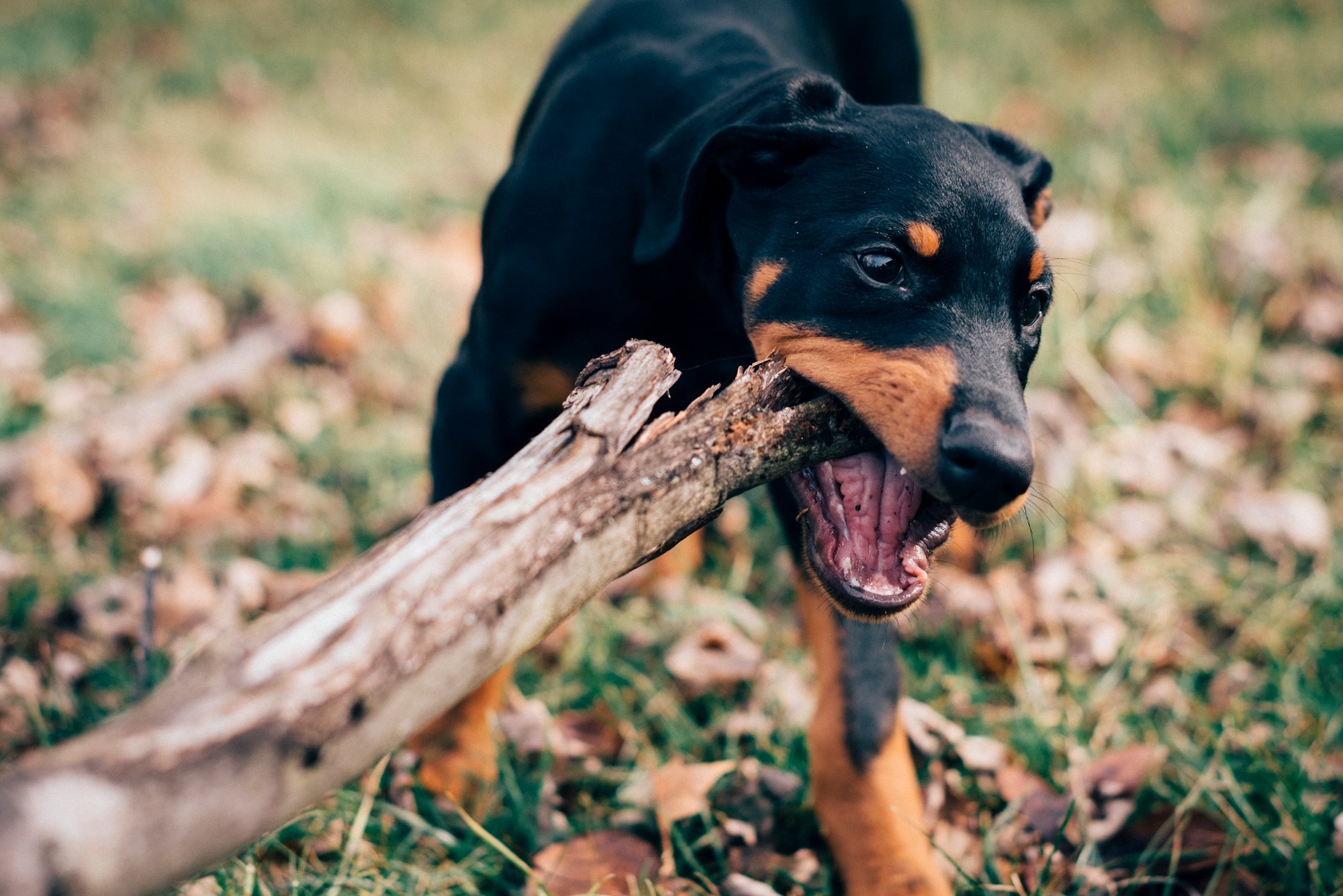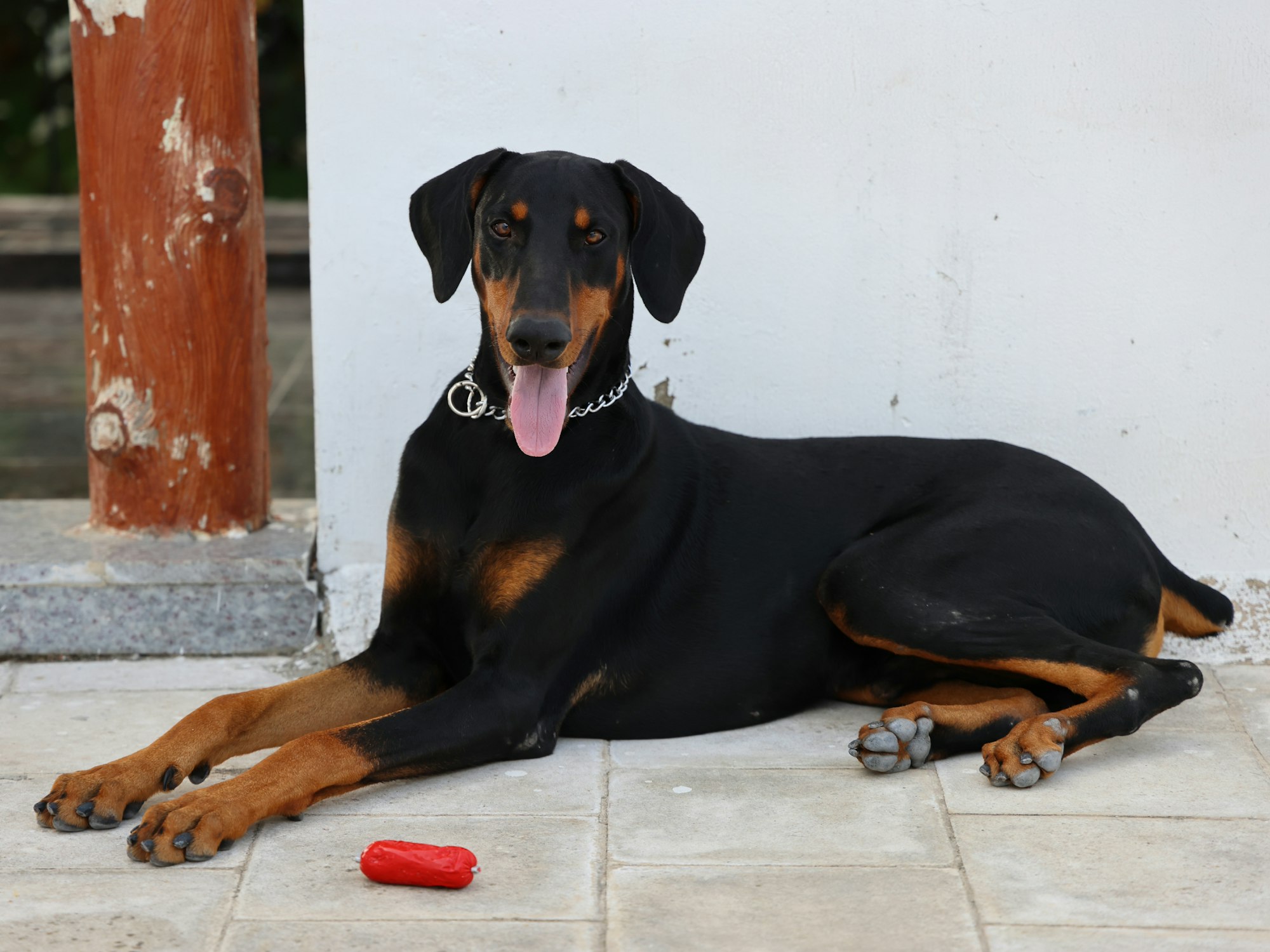It was German tax collector Louis Dobberman who first bred the Doberman (or Doberman/Doberman Pinscher) in 1890. His main objective was to create a dog that would provide maximum protection to humans. Even with subsequent genetic modifications, this protective instinct is still evident in Dobermans today.
If you’ve been wondering how long Dobermans live, then you must spend some time reading this post. Not only does it shed more light on the average lifespan of Dobermans, but it also offers more insight into this energetic, family-oriented, and friendly breed.
How Long Do Dobermans Live?
A Doberman has a lifespan of between 10 and 13 years. This age range can be described as average when compared with the average lifespan of other dog breeds. Some may feel that the Doberman lifespan is rather short.
However, official research conducted in the UK found an even shorter Doberman lifestyle of between 9 and 11 years, and that the oldest Doberman lived for 16.5 years. Many Dobberman parents say their pets have an average lifespan of 9 years.
The relatively shorter average lifespan of Dobermans should not come as a surprise to any dog enthusiast since Dobermans are a large-sized breed. The common trend among dogs is that the larger the size, the shorter the lifespan.
Below is a list of other articles that examine lifespan in other breeds:
From the above, one can conclude that there is nothing unusual about the lifespan of the massive Doberman breed. Moreover, apart from being large, Dobermans are susceptible to a variety of health challenges (more on this later). But size and health problems are not the only determinants of a dog's lifespan. Other variables such as diet, exercise, and overall care also matter.
Notably, there is a variation in the life expectancies of male and female Dobermans. Males have a slightly higher average age than females. Also, statistics indicate that purebred Dobermans live a shorter life, no thanks to the risks that come with inbreeding. In other words, closely linked Dobermans tend to be afflicted with genetic health problems that significantly lower their lifespan.
In contrast, mixed breeds often live longer, thanks to diverse breeding. Because of the vital role of genetics, a DNA test to determine the genetic composition of your Doberman is highly recommended.

The Average Doberman Life Cycle
If you wish to have Dobermans as pets, then a holistic understanding of their life cycle is very important. Such an understanding will help you know exactly what steps to take at every stage of the cycle in order to help your pet live a happy, exciting, and longer life. Below are the various stages of a Doberman’s life cycle.
Puppy
At birth, the newborn puppy’s weight is between 10 and 20 ounces. Being canids, they can neither see nor hear at this stage. After 3 to 5 days, the young puppy’s tails are docked and the dewclaws removed by a vet. Adequate newborn nutrition and care from their mother (and the breeder/pack leader) help them grow healthily and rapidly. At around 2 weeks of age, the eyes start to open, and later on, the ears open up as well. By the fourth week, small puppy teeth start to emerge and the puppies begin to eat solid food.
Around the sixth week, their teeth are fairly developed, meaning that they can now feed independently of their mom and can thus be wholly weaned away from her. Body weight should have increased to between 8 and 12 pounds by now. You’ll also notice continuous increases in their height. The puppies get their first vaccination doses after about 6 to 7 weeks. Between weeks 7 and 12 their ears are cropped by a Vet.
Cropping is a process that involves removing a large part of the outside of the puppy’s ear and subsequently suturing the ear. After suturing, the ears can be taped over the puppy’s head. Alternatively, you can tape the ears and glue them to a wedge of foam, or to a Styrofoam cup (or in any other manner that ensures the ears are kept upright), to make it possible to heal at the edges.
In about 10 days, the sutures are removed, after the ears have healed. You can now roll and tape the ears to make them stand erect rather than sag. Be sure to tape the ears very well and for as long as it will take to make them continue to stand properly.
During the third month, permanent teeth begin to take over as the baby teeth start falling off, meaning that you’ll occasionally see teeth on the floor, though a good number of the falling teeth will be swallowed by the puppy without any bad consequences.
Around the twentieth and twenty-fourth weeks, the puppy will most likely be having two meals a day and some light snacks in between both meals. Do not overfeed the puppy because overweight dogs tend to have a shorter lifespan. Try to keep a constant eye on its weight and body condition. Ensure that it is neither too fat nor too thin.
Adolescent Puppyhood
Adolescent puppyhood commences in the sixth month. A six-month-old puppy looks very much like an adult but is slightly smaller and has grown to about three-quarters of its final height. At this stage, all or most of the puppy’s permanent teeth must have emerged. Standing ears should now be a feature unless the crop is very lengthy, in which case the ear will still be taped. It is around this time that neutering is carried out on male puppies and spaying on females.
By now, all vaccinations are expected to be complete, and the puppy should have attained sufficient maturity to commence obedience classes or training as part of boosting communication and socialization as a whole. Growth and maturity continue in the seventh month, with females almost reaching their full height potential and males expected to catch up a bit later. Both males and females will experience weight gains over the next year, with the former adding more weight than the latter.

Adulthood
The adult stage commences at 12 months of age and continues until the dog turns 7. Puppyhood is now over, and the dog has reached full maturity. He is therefore at his peak or prime at this stage. The adult years are the Doberman’s most active period, both within its immediate family and outside of it. He can communicate and socialize much more effectively, in addition to having a deeper understanding of his immediate environment.
Senior
A seven-year-old Doberman is considered a senior or a veteran. Some will start slowing down at this age, while others will have already slowed down significantly. With the decrease in activities, there is an increased tendency to gain more weight.
More health challenges begin to surface gradually. New dietary and medical requirements will most likely be needed to help cope with old age.
Common Health Issues That Impact The Doberman’s Lifespan
Like all other animals, a variety of health problems bedevil Dobermans at various stages of their life but most especially in old age. Here are a few of the most common health issues faced by Dobermans.
Cancer
According to the National Canine Cancer Foundation, one in three dogs will suffer from cancer sometime in their lives. Furthermore, nearly half of them will die of cancer after diagnosis. The American Veterinary Medical Association also has similar statistics. For them, about 1 in 4 dogs will develop neoplasia at some point in their lives, and half of them over the age of 10 will suffer cancer.
Dobermans are one of the top five breeds most prone to cancer, and many likely die of the deadly condition. In females, mammary cancer is a leading cause of death. Be sure to be on the lookout for signs of cancer by doing lump and bump body checks on a regular basis. Also, watch out for signs and symptoms such as weight loss, change of appetite, reduced energy level, limping, unusual bleeding, vomiting/diarrhea, stiffness, or recurring lameness.
Various treatment options are available but are dependent on the type of cancer and its location. Early detection and treatment can make a huge difference in some cases. So regular vet check-ups will be very helpful, especially for senior Dobermans
Heart Problems
The most common heart problem faced by Dobermans is dilated cardiomyopathy (DCM). Dilated cardiomyopathy is an inherited heart muscle disorder that afflicts Dobermans more than any other dog breed.
DCM brings about ventricular arrhythmia (erratic heartbeats) and sudden death. Around a third of the affected Dobermans show no prior signs of the disease until death comes calling. While some die suddenly, some will recover and live for many more years.
Because of the high rate of the disease in Dobermans, the Doberman Pinscher Club of America advises that they be subjected to an echocardiogram screening and a baseline Holter monitor test at between 1 and 2 years of age. Tests should also be carried out every six months on Dobermans involved in breeding programs. These tests are crucial because they help identify the disease early enough when treatment is most effective.
Von Willebrand Disease
Like DCM, von Willebrand Disease (vWD) is also a very common condition among Dobermans that is also largely hereditary. vWD occurs when a Doberman lacks sufficient von Willebrand factor, a plasma protein that helps platelets link to each other and form clots to close broken blood vessels.
Symptoms include bleeding from the mouth or nose, blood in the urine, bleeding in the gastrointestinal tract (dark tarry stools), and anemia, among others.
DNA tests can facilitate early detection. Though there is no completely effective treatment for vWD yet, it is rarely fatal if properly managed.
Canine Hip Dysplasia (CHD)
Hip dysplasia is a malformation of the hip joint due to improper alignment between the ball and socket. This disorder is mainly caused by nutritional and genetic factors. For instance, research shows that over 70% of puppies overfed during their youth and went on to develop CHD.
It may become manifest in puppyhood or later on as a kind of osteoarthritis. Hip dysplasia has several symptoms, including weakness, pain, reluctance to run, jump, or climbing activity, stiff back legs, difficulty getting up, discomfort or pain when exercising, lameness, and more.
Treating CHD will involve your vet generating an x-ray of your Doberman’s hip sockets and then deciding the best actions to take.
How To Extend The Life Of Your Doberman
Every Doberman owner would like their beloved pet to live as long as possible, if not forever. Well, you have an important role to play if you want your dog to reach and even live beyond its average lifespan. Taking the following measures will help.
Quality Vet care
If you want your pet to live a healthy life for as long as possible, then adequate and frequent attention by a qualified vet is compulsory. A good vet will not only help nip challenges in the bud but also provide qualitative treatment to ensure the longevity of your Doberman. Do not forget that early detection can make a significant difference when it comes to the effective treatment or management of many Doberman health challenges.
Adequate Nutrition and Hygiene
Right from birth to old age, you have to make sure that your Doberman's nutritional intake is sufficient enough to ensure a healthy and lengthy life. Feed your pet with unprocessed meat and avoid foods that may induce obesity and cause health problems that can impact lifespan.
Adding supplements to their diet will help to further complement the nutritional value of the diet program and boost your dog’s ability to resist certain health conditions.
For good hygiene, try to keep your dog, its habitation, and surrounding areas clean all the time.
Moderate Exercise
If you want your dog to exhibit higher levels of strength and agility, then you must put them through physical and mental exercises. One of the many advantages of physical exercise is toning down excess weight. However, just like excess weight, excess physical exercise can lead to joint ailments that may worsen with age.
Looking for an easy way to keep track of your dog’s daily activity level? Fi smart dog collars make it easier than ever. These slender, smart collars feature an activity tracker that counts your pup’s steps and even gives you daily, weekly and monthly goals to meet. It’s almost like a FitBit for your dog that will help you stay on top of Fido’s fitness routine.

Final Thoughts
Dobermans typically have an average lifespan of between 10 and 13 years. This is compatible with or comparable with the average lifespan of similar-sized dogs. At birth, young puppies neither see nor hear and depend largely on their mother for nutrition and care. By six months of age, the young puppies enter the adolescent stage of their lives, a time when they complete their vaccinations and are either neutered or spayed, depending on gender.
By the age of one, the adolescent puppy becomes a fully mature adult that can communicate and socialize most effectively. At seven, old age arrives and slows them down in addition to ushering in health problems associated with aging.
Dobermans face a variety of health challenges, some of which are discussed in this post. If you wish to manage and overcome these challenges, then you should find a good vet, provide your dog with a healthy diet program, and ensure he, his habitation, and his surroundings are always kept clean, in addition to engaging him in lots of mental and moderate physical exercises.
Get more expert advice on pet parenting by visiting the Off Leash blog at TryFi.com.
TryFi's The Fi Dog Collar is a must-have for any pet parent, it's a GPS tracking collar that helps you keep tabs on your dog's location, activity, and sleep patterns, and alerts you if they escape your backyard.






